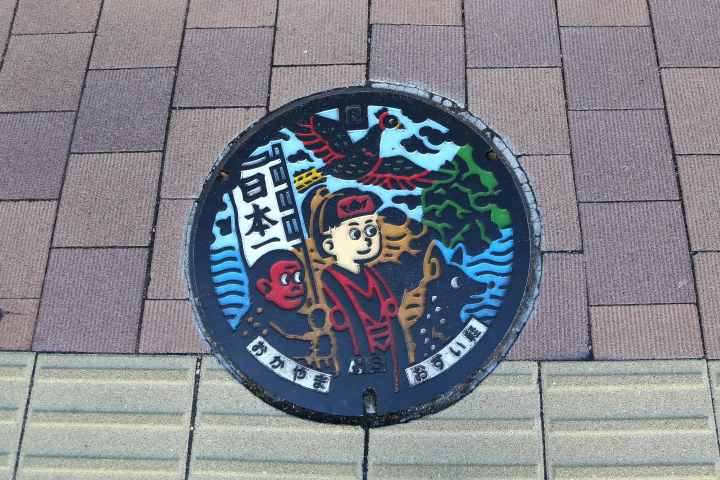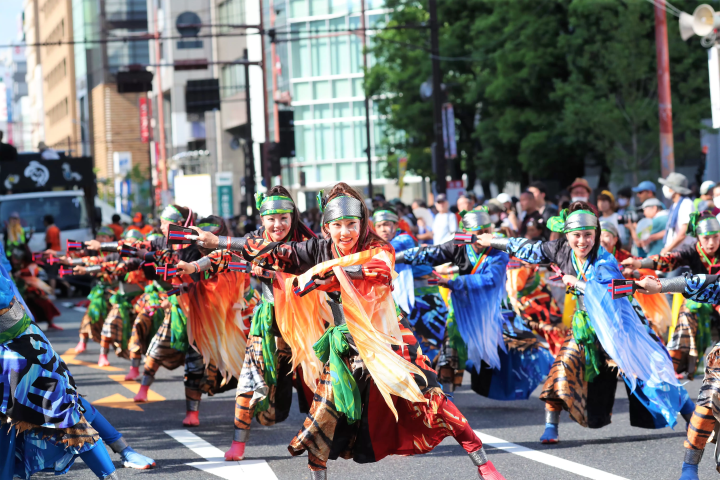Okayama Prefecture, located in the center of western Japan, is known as the birthplace of one of Japan's most famous folktales, "Momotaro." Blessed with a warm climate throughout the year, this region, affectionately known as the "Land of Sunshine," allows you to experience the world of legend in the present day.
2025.02.19
Okayama is a city deeply connected to "Momotaro," one of Japan's most famous folk tales. Momotaro is beloved as a symbol of courage, kindness, and unity, and there are many spots in Okayama where you can experience this legend. From the bronze statues in front of Okayama Airport and Okayama, to the shrines where the legend is said to have taken place, to peach-themed fortune-telling slips and amulets, and Momotaro-themed souvenirs, embark on a journey to experience the world of Momotaro.
-
Table of contents
- What is Momotaro?
- A journey through the legend: Places associated with Momotaro
- Momotaro-themed gourmet food and souvenirs
- "Uraja" adds color to Okayama's summer
- Access and tourist attractions
- Experience the world of Momotaro in Okayama
What is Momotaro?

Momotaro is one of the most beloved Japanese folk tales. One day, an old woman was washing clothes by the river when she found a huge peach. When she cut the peach open, a lively boy was born. The old man and woman named the child "Momotaro" and raised him with great care.
As he grew up, Momotaro decided to set out on a journey to defeat the demons that were tormenting the villagers. Along the way, he met a dog, a monkey, and a pheasant, all of whom he shared his special "Kibi Dango" (millet dumplings), and they became his loyal servants. Momotaro, who joined forces with his friends and successfully defeated the demons of Onigashima, is still remembered today as a true hero.
A journey through the legend: Places associated with Momotaro
Okayama is dotted with tourist spots related to Momotaro.
Momotaro Statue and Momotaro Street

In front of Okayama Station, there are bronze statues of the story's protagonist, Momotaro, along with a dog, a monkey, and a pheasant, making it the perfect starting point for your sightseeing. (Note: Currently being temporarily relocated due to construction work to open a tram line, it is scheduled to be reinstalled near the new tram stop in the station square around March 2027.) Statues of Momotaro and his animal companions are scattered throughout Momotaro Street, which continues from the station, allowing you to experience the legend as you stroll along the street. There is also a guardrail post modeled after the demon's iron club, called the "Oni no Kanabao Guard," which allows you to enjoy the world of Momotaro throughout the entire street.



Kibitsu-jinja Shrine:

Kibitsu-jinja Shrine, designated a national treasure, is a historic shrine dedicated to Kibitsuhiko-no-Mikoto, who is said to be the inspiration behind the Momotaro legend. Its magnificent corridor, stretching a total of 398 meters, is known as a masterpiece of architectural beauty. You can enjoy the beautiful scenery of each season, with cherry blossoms in the spring, hydrangeas in early summer, and autumn leaves in the fall.
Kibitsuhiko-jinja Shrine

Kibitsuhiko-jinja Shrine, which also enshrines Kibitsuhiko-no-Mikoto, is attractive for its solemn atmosphere, where traditional shrine architecture harmonizes with deep greenery. The main shrine is designated as a prefectural important cultural property and is located on Nakayama no Nakayama, which has long been worshipped as a sacred mountain. On the summer solstice, the Asahi rises directly in front of the torii gate, so it is also known as Asahi no Miya, or "Palace of the Asahi Sun," and is popular as a power spot.
Peach-themed charms and fortune-telling slips are popular.
Kinojo Castle(Demon Castle)

This ancient mountain castle in Soja City is said to be the castle of the ogre that Momotaro defeated. It has been selected as one of Japan's 100 most famous castles, and the remains of the ancient mountain castle remain in this area, making it a place often associated with the Momotaro legend. A magnificent view unfolds from the castle ruins, making you feel as if you are standing on the stage where Momotaro fought the ogre.
Momotaro-themed gourmet food and souvenirs
When you visit Okayama, be sure to enjoy the local specialties and gourmet food associated with Momotaro.
Kibi Dango

Kibi Dango, famous for being served by Momotaro to his friends, is a specialty sweet of Okayama. It originally came from the food culture of the Kibi region, which has been passed down since ancient times, and was also eaten as a portable food by samurai. Due to the influence of the story, it is now widely loved as a symbol of Momotaro.
Momotaro Goods

Momotaro Goods: There are many Momotaro-themed products available, including stuffed toys, key chains, and Okayama exclusive goods. Charms and stationery with Momotaro designs are especially popular with tourists.

Okayama City has manhole covers with designs based on the legend of Momotaro installed throughout the city. These manhole covers were designed by Okayama City officials and began to be installed in 1986.
The main locations for the manhole covers are around Okayama Station, Omotemachi Shopping Arcade, and near Korakuen Garden, and are located in areas that are easy for tourists to visit. In particular, the Okayama Shopping Arcade and Prefectural Office Street (near Omotemachi Shopping Arcade) have been outfitted with colorful manhole covers in collaboration with the popular game "Momotaro Dentetsu."
White peach related products

Okayama is also famous for its white peaches. In honor of the "peach" in Momotaro, sweets, juice, cosmetics, and other products made with white peaches are sold as local specialties. Okayama's white peaches in particular are known for their strong sweetness and refined flavor.
"Uraja" adds color to Okayama's summer

"Uraja" is one of the largest summer festivals in Okayama Prefecture, held every August. It was born from the legend of Momotaro, which is passed down in Okayama and depicts the battle between Kibitsuhiko-no-Mikoto (Momotaro) and Ura (the demon god).
At Uraja, dancers dressed in colorful costumes walk through the streets performing "Uraja Ondo" songs and original choreography. With their faces adorned with unique "Ura makeup," the streets of Okayama are filled with energy and smiles. Both local residents and tourists can participate, making it a rare opportunity to experience Okayama culture up close.
Access and tourist attractions

Okayama is located Nakama between major tourist destinations such as Kyoto, Osaka, and Hiroshima , and is easily accessible by Shinkansen. It also occupies an important position as the gateway to Shikoku via the Seto.
Okayama is also home to many historical tourist spots, including Okayama Korakuen Garden, one of Japan's three most famous gardens, Okayama Castle, and the atmospheric Kurashiki Bikan Historical Quarter. Okayama, known as the "Fruit Kingdom," is particularly famous for its white peaches, and you can also taste Muscat and Pione grapes.
Experience the world of Momotaro in Okayama

The story of Momotaro is not just a folk tale, but a symbol of courage, friendship, and justice that remains deeply rooted in the hearts of the people of Okayama. Why not embark on a journey following in Momotaro's footsteps, visiting historical spots and enjoying traditional flavors? Come and find your own unique Momotaro experience in Okayama.
The contents on this page may partially contain automatic translation.




![A 398-meter long corridor!? The inspiration for the Momotaro legend!? [Kibitsu-jinja Shrine]](https://resources.matcha-jp.com/resize/200x2000/2024/12/27-217410.webp)





![[2025] A Complete Guide to the JR Okayama Station Shinkansen Platform! Food, Souvenirs, Transfers, and More](https://resources.matcha-jp.com/resize/200x2000/2024/11/29-212729.webp)





![[2025 Edition] Osaka Departure! A 2- Tomari, 3-Day Classic itinerary of Okayama and Hiroshima](https://resources.matcha-jp.com/resize/200x2000/2024/11/25-211829.webp)
